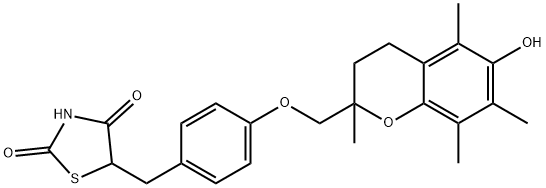WY-14643
Synonym(s):4-Chloro-6-(2,3-xylidino)-2-pyrimidinylthioacetic acid;Pirinixic acid
- CAS NO.:50892-23-4
- Empirical Formula: C14H14ClN3O2S
- Molecular Weight: 323.8
- MDL number: MFCD00191335
- SAFETY DATA SHEET (SDS)
- Update Date: 2025-12-28 08:51:53

What is WY-14643?
Description
WY-14643 (50892-23-4) is a selective PPARα agonist (EC50=0.63, 32 and >100 μM for PPARα,γ and δ, respectively).1? Displays anti-inflammatory activity2 and reduces LPS-induced inflammation in alveolar epithelial cells3. Induces “browning” of white adipocytes in combined treatment with retinoic acid.4? Stimulates ADAM10-mediated proteolysis of? amyloid precursor protein in a mouse model.5 Down regulates NFkB transcriptional activity. Review.6
The Uses of WY-14643
WY-14643 has been used:
- as a positive control for transfection and luciferase assay
- to stimulate bone marrow–derived macrophages (BMDM) for autophagic flux analysis
- to analyze the regulation of fatty acid metabolism-immune nexus (FAMIN) expression in cell culture
The Uses of WY-14643
A highly potent PPARα agonist
What are the applications of Application
WY 14643 is a highly potent PPARα agonist
Definition
ChEBI: Pirinixic acid is a member of pyrimidines, an organochlorine compound and an aryl sulfide. It is functionally related to an acetic acid.
General Description
WY-14643 prevents lipopolysaccharide (LPS)-induced inflammation in synovial fibroblasts. It protects cortical neurons from pro-inflammatory mediator-induced cell injuries. WY-14643 has inhibitory effects on pro-inflammatory responses in microglia. It improves oxido-nitrosative stress in disease models and reduces the generation of reactive oxygen species (ROS), nitric oxide (NO) and lipid peroxidation end-products in the brain.
Biological Activity
Selective PPAR α agonist (EC 50 values are 0.63, 32 and > 100 μ M at PPAR α , PPAR γ and PPAR δ respectively). Negatively inhibits NF- κ B transcriptional activity and decreases the inflammatory response in vitro and in vivo .
Biochem/physiol Actions
Selective PPARα agonist.
Safety Profile
Moderately toxic by ingestion. Suspected carcinogen with experimental carcinogenic and tumorigenic data. Mutation data reported. When heated to decomposition it emits very toxic fumes of Cl-, NOx and SOx
Storage
Store at RT
References
1) Forman et al. (1997), Hypolipidemic drugs, polyunsaturated fatty acids and eicosanoids are ligands for peroxisome proliferator-activated receptors alpha and delta; Proc. Natl. Acad. Sci. USA, 94 4312 2) Devchand et al. (1996), The PPARalpha-leukotriene B4 pathway to inflammation control; Nature, 384 39 3) Heckler et al. (2015), PPAR-a activation reduced LPS-induced inflammation in alveolar epithelial cells; Exp. Lung Res., 41 393 4) Wang et al. (2015), WY14643 combined with all-trans retinoic acid acts via p38 MAPK to induce “browning” of white adipocytes in mice; Genet. Mol. Res., 14 6978 5) Corbett et al. (2015), Activation of peroxisome proliferator-activated receptor alpha stimulates ADAM10-mediated proteolysis of APP; Proc. Natl. Acad. Sci. USA, 112 8445 6) Merk et al. (2015), Pirinixic acids: flexible fatty acid mimetics with various biological activities; Future Med. Chem., 7 1597
Properties of WY-14643
| Melting point: | 155°C |
| Boiling point: | 514.4±50.0 °C(Predicted) |
| Density | 1.2984 (rough estimate) |
| refractive index | 1.5630 (estimate) |
| storage temp. | Keep in dark place,Sealed in dry,Room Temperature |
| solubility | Soluble in DMSO (up to 40 mg/ml). |
| pka | 2.99±0.10(Predicted) |
| form | White crystalline solid |
| color | Off-white |
| Stability: | Stable for 2 years from date of purchase as supplied. Solutions in DMSO or ethanol may be stored at -20°C for up to 6 months. |
Safety information for WY-14643
| Signal word | Danger |
| Pictogram(s) |
 Exclamation Mark Irritant GHS07  Health Hazard GHS08 |
| GHS Hazard Statements |
H302:Acute toxicity,oral H315:Skin corrosion/irritation H319:Serious eye damage/eye irritation H335:Specific target organ toxicity, single exposure;Respiratory tract irritation H350:Carcinogenicity |
| Precautionary Statement Codes |
P201:Obtain special instructions before use. P302+P352:IF ON SKIN: wash with plenty of soap and water. P305+P351+P338:IF IN EYES: Rinse cautiously with water for several minutes. Remove contact lenses, if present and easy to do. Continuerinsing. P308+P313:IF exposed or concerned: Get medical advice/attention. |
Computed Descriptors for WY-14643
New Products
4,4-Difluoropiperidine hydrochloride tert-butyl 9-methoxy-3-azaspiro[5.5]undecane-3-carboxylate Indole Methyl Resin N-Isopropylurea N,N-Dicyclohexylcarbodiimide(DCC) MELDRUMS ACID 5-METHYLISOXAZOLE-4-CARBOXYLIC ACID Magnessium Bis glycinate Zinc ascorbate 1-bromo-2-butyne 2-acetamidophenol 9(10H)-anthracenone Erythrosin B, 4-Piperidinopiperidine 2-((4-morpholinophenylamino) (methylthio) methylene) malononitrile 2,4-dihydroxybenzaldehyde 3-(4-morpholinophenylamino)-5-amino-1H-pyrazole-4-carbonitrile Methyl 2-methylquinoline-6-carboxylate 2,6-dichloro-4-nitropyridine 4-Bromo-2-chlorobenzonitrile 2-(benzylamino)acetic acid hydrochloride 4-(tert-Butoxycarbonylamino)but- 2-ynoic acid 3,4-dihydro-2H-benzo[b][1,4]dioxepine 1-Phenyl-1-cycloprppanecarboxylicacidRelated products of tetrahydrofuran
You may like
-
![[4-Chloro-6-(2,3-xylidino)-2-pyrimidinylthio]acetic Acid CAS 50892-23-4](https://img.chemicalbook.in//Content/image/CP5.jpg) [4-Chloro-6-(2,3-xylidino)-2-pyrimidinylthio]acetic Acid CAS 50892-23-4View Details
[4-Chloro-6-(2,3-xylidino)-2-pyrimidinylthio]acetic Acid CAS 50892-23-4View Details
50892-23-4 -
 WY-14643 CAS 50892-23-4View Details
WY-14643 CAS 50892-23-4View Details
50892-23-4 -
 3-(4-amino-1-oxoisoindolin-2-yl)-1-methylpiperidine-2,6-dione 98%View Details
3-(4-amino-1-oxoisoindolin-2-yl)-1-methylpiperidine-2,6-dione 98%View Details -
 614-19-7 98%View Details
614-19-7 98%View Details
614-19-7 -
 20677-73-0 (2,2-diethoxyethyl)methylamine 98%View Details
20677-73-0 (2,2-diethoxyethyl)methylamine 98%View Details
20677-73-0 -
 3-(4-(hydroxyamino)-1-oxoisoindolin-2-yl)piperidine-2,6-dione 98%View Details
3-(4-(hydroxyamino)-1-oxoisoindolin-2-yl)piperidine-2,6-dione 98%View Details -
 57381-49-4 2-bromo-4-chlorobenzonitrile 98%View Details
57381-49-4 2-bromo-4-chlorobenzonitrile 98%View Details
57381-49-4 -
 4,6-dichloropyrimidine-5-carbaldehyde 98%View Details
4,6-dichloropyrimidine-5-carbaldehyde 98%View Details
5305-40-8








